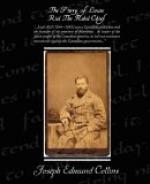All this while Major Morris and his police, and nearly two hundred able bodied men, with 200 rifles and plenty of ammunition were cooped up in the Fort, peeping out at the squaws pillaging the town. It seems a little illogical that we should call out our young men from Halifax, from Quebec, from Montreal, from Kingston, from Ottawa, and from the other cities that put forces into the field, to go out into the far wilderness to protect property, when able-bodied men with arms in their hands stood by and watched unmoved a body of savages and squaws pillage their town, and give their property to the flames. It was to relieve this town that Colonel Otter made the brilliant march, upon which writers and orators have not been able to bestow enough of eulogy.
CHAPTER XV.
After the defeat of the police and civilians at Duck Lake, Riel and Dumont felt thoroughly confident of being able to deal with the forces which they were apprised the Canadian Government would send into the field against them. They held many long consultations together, and in every case it was Dumont who laid down the details of the military campaign. “These Canadian soldiers,” he would say, “can not fight us here. We will entrench ourselves in positions against which they may fire cannon or gatling guns in vain. They are not used to bush-fighting, and will all the time expose themselves to our bullets. Besides, distances here are deceptive; and in their confusion they will make the wildest sort of shooting.” It was decided that the rebel forces should make their main stand at an advantageous position, which Dumont had accidentally observed one day when he was out elk-stalking three years ago. This place, he assured his chief seemed to be intended by nature for a post of defence. It lay a short distance from Batoche’s Crossing.
“But my idea is to engage them several times with portions of my force; gradually to fall back, and then fight at my final ground the battle which shall decide who is master in these territories, the half-breeds or the Canadian volunteers.”




